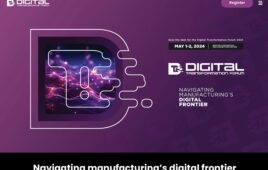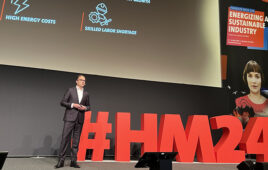Alan Griffiths, Principal Consultant, Cambashi
Cambashi recently completed a research project into the industrial application of the Internet of Things (IoT). The aim was to establish the market’s structure and direction based on interviews with major players combined with desk research.
Many of the technologies that make up Industrial IoT are well established in their own right. The diagram below shows six ‘layers’ that make up what most people consider to be the Industrial IoT.

Many of the technologies that make up Industrial IoT are established Here are the six layers that most people consider to be a part of the Industrial IoT.
Here’s a look at what’s new about each one:
Mechanical parts
This can cover anything from vehicles to component parts. Most publicity has so far been around personal IoT devices such as fitness monitors and home appliance controls. But recent surveys show that the Industrial applications of IoT are growing faster.
Electronics, software, sensors and actuators
These days, every consumer and industrial item with a battery or an on/off switch almost certainly includes software-controlled electronics, technologies that have been around for decades. A recent trend is that component providers who offer all the digital metadata that describes their components may well have an advantage at this stage, because the metadata can feed into systems engineering and other tools, thus helping the project team structure, simulate, then plan the development project. Many teams responsible for control software are used to developing for the closed environment of a standalone machine. Making use of new network connectivity can be a disruptive but positive change for these teams.
Connectivity
This is the means by which products communicate with the back-end systems and includes a range of methods from proprietary to standards-based. Of course, it has been possible to connect devices for some time, but historically this has used proprietary, custom-built systems. Today, cloud computing provides a more convenient and cost-effective way to connect to other systems.
Two other areas where innovation is improving connectivity are:
Edge computing – such as servers located close to the smart products or factories that act as a collection point for the data. Because vast amounts of data can be collected from the billions of devices in the field, it makes sense to do as much data processing and selection as possible, near to the devices or sensors. This means that less data has to be transmitted to the cloud and less processing will later be required.
Evolving connectivity standards: the Industrial Internet of Things Connectivity Framework (IIC:PUB:G5:V1.0:PB:20170228) from the IIC (Industrial Internet Consortium) lists ten Core Standard Criteria ranging from ‘Providing syntactic interoperability’ to ‘Having readily-available SDKs.’ Against these, it rates four Connectivity Standards – DDS; Web Services; OPC-UA and oneM2M. Each of these standards is evolving to provide specific advantages in Industrial IoT implementation. For example, DDS is an emerging, new standard; its main distinguishing feature is that, unlike the other three, DDS has no concept of messages – the software application talks to the ‘databus’ for a more efficient solution when the data has many destinations.
Product access and data routing
Almost every connected product has more than one organization interested in reading its data, and sending it commands. The Product Access and Data Routing layer controls and manages who has access to what. For example, the manufacturer of a machine, and a third-party service company may offer machine monitoring, optimization and predictive maintenance. What data will they see? What settings can they change? If something is changed, who is responsible for documenting the change and matching it to other records of use of the machine (for example, batches of food production)? Can the machine owner, or a local operator, or an on-site service technician control this access? The company that supplied the electric motors inside the machine may offer an automated motor monitoring service. Who will authorize their computer systems to gather data from the motors? These data flows form a complex network, but it is worth noting that Product Lifecycle Management (PLM) systems have for many years handled access control to manage these kinds of data flows to and from design data. Repurposing and scaling this to cover all operational machines may not be straightforward, but PLM contains relevant experience of the necessary business logic and procedures.
Product-specific software applications
This is the heart of many new capabilities of smart, connected products. For example, a new capability to observe and analyze the status of a set of connected devices, and make a plan to operate or service them, will be provided by software in this layer. This layer also has the role of making appropriate connections and integration with other enterprise applications. For example, an update to embedded software will only be sent to devices used by customers with a valid subscription – and it is the CRM (customer relationship management) or perhaps sales order processing system that has this information.
Other enterprise applications
Maintenance, Repair, Operations (MRO) may well be the focus of a smart connected product initiative, perhaps a switch from fixing breakdowns to usage-based or predictive maintenance. But many MRO issues stay the same: fault handling, whether real or predicted; configuration; part or software availability for fix; schedule technician or online access to product; fix problem, report the fix; share the know-how; customer acceptance. So the emphasis on the use of tools is probably on tracking orders and configurations, scheduling technicians and parts for maintenance and fault fixing. Good integration of these applications enable companies to supplement their products with additional services.
To summarize, ‘smart products,’ have been around for 20 years or more. But these were only used on high-value, long-life equipment.
What is leading to the multi-trillion dollar market with billions of sensors on-line? This is answered succinctly by Rhonda Dirvin, director IoT vertical markets for ARM (now part of Softbank): “The first driver for the spread of Industrial IoT was the proliferation of mobile phones, which drove down the cost of sensors – cameras, GPS, accelerometers.
“This drove down the cost of acquiring data. At the same time, Cloud computing emerged, which provided a platform where these data could be stored and analyzed relatively cheaply. Altogether, these developments provide the basic framework for IoT. Other technologies such as Big Data, AI (artificial intelligence) and Machine Learning are now coming into play to help make sense of this data, taking it to a whole new level.”
There is little doubt that the Industrial IoT will continue to be disruptive – changing conventional business and software implementation models – and that the main elements, shown in the six-layer model above, are in place to support this.
But there is still plenty of room for innovation in the way the Industrial Internet of Things is applied, the way smart-connected devices are developed and manufactured, and the capabilities of the tools and components used across all six layers of IOT.
This innovation will increasingly be in response to business rather than technical needs or opportunities as the supporting technology becomes more mature and affordable.
Cambashi
www.cambashi.com
Filed Under: IoT • IIoT • Internet of things • Industry 4.0





Tell Us What You Think!